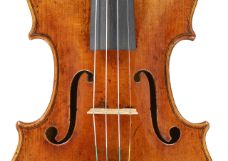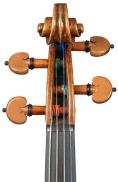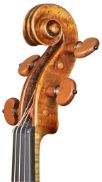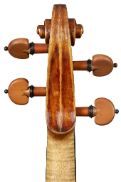Violin, Santo Serafin, Venice, after 1748, “ex Hamma”
Copperplate engraved label with garlands and figurative representations: “Sanctus Seraphin / Utinensis Fecit / Venetijs Anno 1742” (42 handwritten). Raised brand stamp on the lower ribs near the end button: “SANTO / SERAFIN”The light, transparent varnish, the model and the f-hole design signal that this instrument was built by Santo Serafin. Additionally, the shape of the back arching is typical of the Venetian master: The highest point of the arch is not located in the acoustic center; much rather, it is lower, almost at the mid-point between the lower corners. The printed addition “Utinensis” on the violin label indicates Serafin’s origin, Udine. Serafin also put a “reversed” brand mark on the lower rib above and below the end button, where the letters are raised from the burnt, impressed background. The two-piece belly has an extremely fine grain, with the annual rings becoming wider toward the edge. According to a dendrochronological report, the instrument must have been made after 1748. The two-piece, quarter-cut back displays close and very regular flames in an open V shape. The structure of the rib wood is like that of the back. The pegbox and scroll are fashioned from unflamed maple. The arching curves are very harmonious and full, with the back arch higher than the belly arch. Whereas Stradivari’s style and thus also his f-hole design generally prevailed in the mid-18th century in Cremona, many Venetian masters remained true to Amati’s and Stainer’s designs. Santo Serafin’s f-hole design is a case in point: The f-holes are positioned upright in the belly and are short with marked curves, and both wings have almost identical width. The lower eyes are considerably larger than the upper ones. Serafin’s outstanding skill becomes apparent in the workmanship of the purfling, which is very close to the edge. The shape of the delicate-looking scroll with its deeply cut volutes and sharp edges is flawless. The golden-yellow, luminous ground covered by a transparent, orange-red varnish still intact above all on the back and the ribs is typical of Santo Serafin. The name of the instrument stems from Hamma company in Stuttgart, which owned the violin for an extended period.












